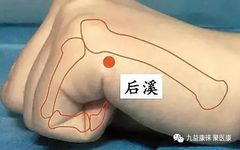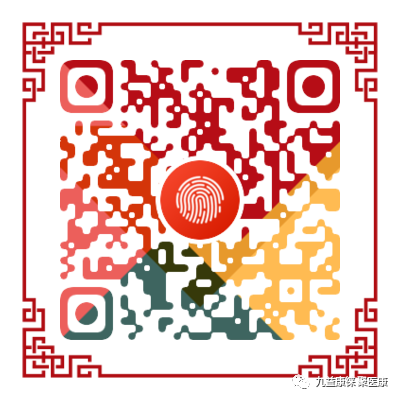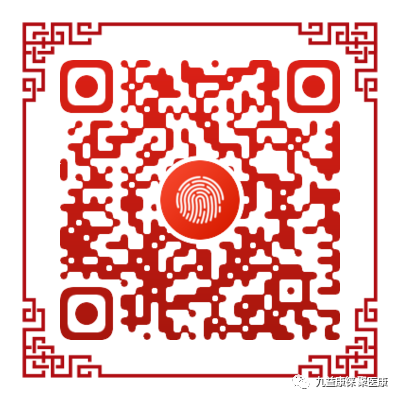

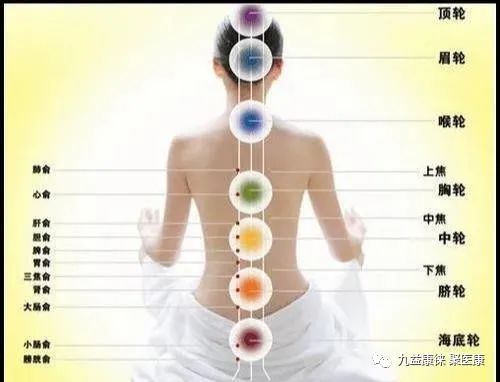
Introduction: Beyond the twelve regular meridians, there are eight extraordinary meridians, known as the Eight Extraordinary Meridians (qi jing ba mai). They play a crucial role in connecting, maintaining, and regulating the twelve meridians, and are of great importance in Daoist health cultivation practices. Understanding these meridians can help enhance the practice of tapping techniques.
The Eight Extraordinary Meridians consist of the Ren Mai (Conception Vessel), Du Mai (Governing Vessel), Chong Mai (Penetrating Vessel), Da Mai (Belt Vessel), Yin Qiao Mai (Yin Heel Vessel), Yang Qiao Mai (Yang Heel Vessel), Yin Wei Mai (Yin Linking Vessel), and Yang Wei Mai (Yang Linking Vessel). Unlike the twelve regular meridians, they do not directly connect to the organs and do not have a paired relationship, hence they are termed extraordinary. Their primary function is to facilitate communication between the twelve meridians and regulate the flow of qi and blood within them.
1. Du Mai
The Du Mai runs along the midline of the back and intersects multiple times with the three Yang meridians of the hands and feet, as well as the Yang Wei Mai, thus it is referred to as the “Sea of Yang Meridians”. The Du Mai travels along the spine, ascends into the brain, and branches off to connect with the kidneys, establishing a close relationship with the brain, spinal cord, and kidneys.
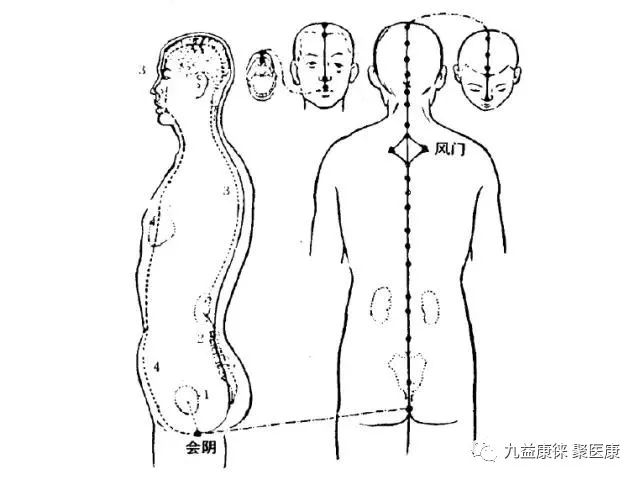
1) Pathway: The Du Mai originates in the lower abdomen, exits at the perineum, travels backward to the Changqiang point (长强穴), ascends along the spine, passes through the nape to the Fengfu point (风府穴), enters the brain, and follows the midline of the head to the Baihui point (百会穴), descends through the forehead to the Su Liao point (素寥穴) at the tip of the nose, crosses the philtrum, and reaches the Ging Jiao point (龈交穴) at the center of the upper gums.
2) Branches:
The first branch originates with the Chong and Ren meridians from the lower abdomen, exits at the perineum, and connects with the Kidney meridian and Bladder meridian at the tailbone.
The second branch ascends directly from the lower abdomen through the navel, travels upward to the throat, intersects with the Chong and Ren meridians, and encircles the lips, reaching the center below the lower jaw.
The third branch begins at the inner canthus of the eye, ascends to the forehead, meets at the Baihui point, and then branches down the back of the neck, along the scapula, and reaches the lumbar region, connecting with the kidneys.
3) Physiological Functions:
1. Regulates the qi and blood of the Yang meridians, serving as the “Sea of Yang Meridians”: The Du Mai runs along the back, which is Yang in nature, indicating its role in overseeing and regulating the qi of all Yang meridians. Additionally, all six Yang meridians intersect at the Dazhui point (大椎穴), further emphasizing the Du Mai’s regulatory function over Yang meridians.
2. Reflects the functions of the brain, kidneys, and spinal cord: The Du Mai is associated with the brain and connects with the kidneys. The kidneys produce marrow, and the brain is considered the sea of marrow, establishing a close relationship between the Du Mai, brain, kidneys, and spinal cord.
3. Governs reproductive functions: The Du Mai connects with the kidneys, which are responsible for reproduction, thus it is related to reproductive health.
4) Key Acupoint: Houxi (后溪)
The Houxi point governs the Du Mai and can treat issues related to it, such as neck and shoulder problems, lumbar disc disease, spinal pain, and lordosis. To locate the Houxi point, make a fist and find the point at the distal wrist crease behind the fifth finger joint (the end of the transverse crease behind the metacarpophalangeal joint).
In daily practice, we can tap the Houxi point with both hands or place the Houxi area on the edge of a table and roll back and forth using the wrist joint to stimulate the point. During tapping or rolling, a slight soreness may be felt. Spending just three to five minutes daily on this can significantly benefit the cervical and lumbar spine.
2. Ren Mai
The Ren Mai runs along the midline of the abdomen and intersects multiple times with the three Yin meridians of the hands and feet, thus it is referred to as the “Sea of Yin Meridians”. The Ren Mai originates in the lower abdomen and is associated with women’s pregnancy, hence the saying “Ren governs the uterus”.
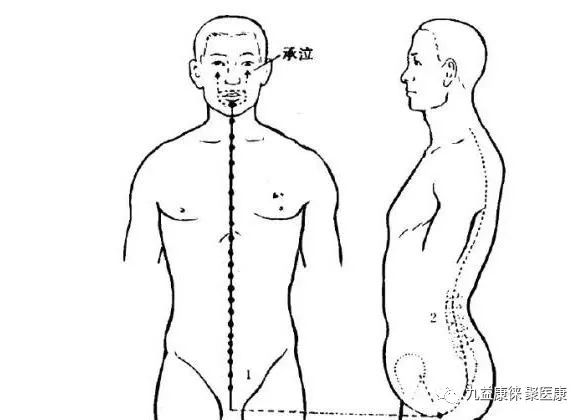
1) Pathway: The Ren Mai starts in the lower abdomen, exits at the perineum, travels through the Yin region, ascends along the midline of the abdomen, passes through the throat (Tian Tuo point), reaches the inner lower lip, encircles the lips, intersects with the Du Mai at the Ging Jiao point, and then ascends to the lower eye socket (Cheng Qi point), connecting with the Yangming meridian.
2) Branches: It runs from the lower abdomen along the spine.
3) Physiological Functions:
1. Regulates the qi and blood of the Yin meridians, serving as the “Sea of Yin Meridians”: The Ren Mai runs along the midline of the abdomen, which is Yin in nature, indicating its role in overseeing and regulating the qi of all Yin meridians. Additionally, the three Yin meridians intersect with the Ren Mai, thus it has a regulatory function over Yin meridians.
2. Regulates menstruation and supports fetal development: The Ren Mai originates in the lower abdomen and plays a role in regulating menstruation and promoting women’s reproductive functions, hence the saying “Ren governs the uterus”.
4) Key Acupoint: Lie Que (列缺)
The Lie Que point governs the Ren Mai and can regulate its qi, thus treating disorders of the Ren Mai. The Lie Que point is easily located, situated 1.5 cun above the wrist crease on the radial side of the radius. To locate it, cross the thumbs and find the depression where the index finger touches.
Additionally, the Huangdi Neijing states that the Lie Que point primarily treats migraines, headaches, and stiff necks. The Great Compendium of Acupuncture includes a famous verse stating, “For neck and above ailments, seek Lie Que,” indicating that this point can be used to treat and regulate conditions above the neck.
3. Chong Mai
The Chong Mai extends from the head to the feet, traversing the entire body; it serves as a crucial point for regulating the qi and blood of the twelve meridians, hence it is called the “Sea of the Twelve Meridians” or “Blood Sea”. It is also related to women’s menstruation.
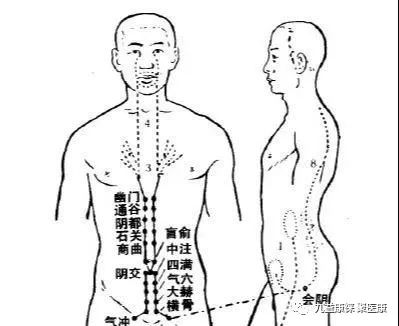
1) Pathway:
It originates in the uterus, exits at the perineum, and divides into two branches. The ascending branch (the main trunk of the Chong Mai) runs along the anterior abdominal wall, near the navel (5 fen from the navel), ascends, intersects with the Kidney meridian, spreads through the chest, ascends through the throat, and encircles the lips; the descending branch runs along the posterior abdominal wall, ascending along the spine. The descending branch exits the perineum and descends along the inner thigh to the big toe.
2) Physiological Functions:
1. Regulates the qi and blood of the twelve meridians: The Chong Mai runs from the head to the feet, traversing the entire body, serving as a crucial point for regulating the qi and blood of all meridians. When the qi and blood of the meridians and organs are abundant, the Chong Mai can store and accumulate them; when they are deficient, the Chong Mai can supply and nourish them, maintaining the normal physiological activities of the body’s organs and tissues. Thus, it is referred to as the “Sea of the Twelve Meridians”, “Sea of the Five Zang and Six Fu”, and “Blood Sea”.
2. Governs reproductive functions: The Chong Mai originates in the uterus, also known as the “Blood Chamber” or “Blood Sea”. It plays a role in regulating menstruation. The Chong Mai is closely related to reproductive functions; for women, “When the Chong Mai is abundant, menstruation occurs regularly, leading to conception.” Conversely, if the Chong Mai is deficient, it can lead to reproductive issues.
3. Regulates the ascending and descending of qi: The Chong Mai connects with the Kidney meridian, belongs to the Yangming, and communicates with the Jueyin and Taiyang. It has the function of regulating the ascending and descending of qi in certain organs (mainly the liver, kidneys, and stomach).
3) Key Acupoint: Gong Sun (公孙)
The “Gong Sun governs the Chong Mai and the stomach and chest”, indicating that it can address issues related to the stomach and chest, such as common stomach pain, vomiting, abdominal pain, diarrhea, dysentery, anxiety, insomnia, and qi rising to the heart. The acupoint is located on the inner side of the foot, below the high bone of the foot, at the point where pressure causes a feeling of soreness or pain.
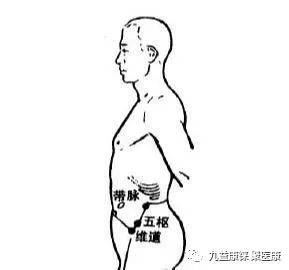
4. Da Mai
The Da Mai originates at the lower ribs and descends diagonally to the Da Mai point, encircling the body like a belt, and can restrain the meridians that run vertically.

1) Pathway: The Da Mai originates at the fourteenth vertebra, at the lower ribs, descends diagonally to the Da Mai point, encircling the body, and then descends along the upper edge of the hip bone to the lower abdomen.
2) Physiological Functions: It restrains the vertical meridians and governs women’s leukorrhea.
3) Key Acupoint: Zu Lin Qi (足临泣)
The Zu Lin Qi point governs the Da Mai, which encircles the body like a belt, enhancing the connection of qi and blood flow between the meridians, making it a vital health meridian. Therefore, Zu Lin Qi can effectively treat women’s gynecological issues, lower back pain, and can also promote the Yang energy of the body.
The Zu Lin Qi point is located on the outer side of the foot, in the gap between the fourth and fifth metatarsal bones, and can be stimulated by tapping the dorsum of the foot.
5. Yin Qiao Mai
The Yin Qiao Mai runs from the feet to the head, located on the Yin side of the body, and is responsible for nourishing the eyes, controlling eyelid movement, and lower limb movement.
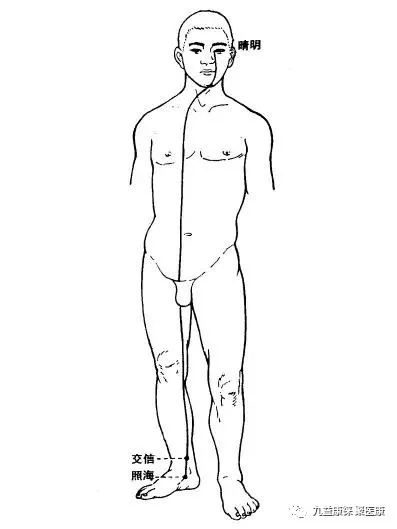
1) Pathway: The Yin Qiao Mai originates at the inner side of the heel from the Zhaohai point (照海穴) of the Kidney meridian, ascends along the inner ankle, travels up the inner thigh to the front of the pelvis, ascends along the abdominal front, reaches the chest, and ascends to the throat, reaching the side of the nose, connecting with the inner canthus of the eye, and meeting with the Yang Qiao and Taiyang meridians.
2) Physiological Functions:
It controls the opening and closing of the eyes and muscle movement.
3) Key Acupoint: Zhaohai (照海)
The Zhaohai point is an important acupoint for treating throat issues, as it governs the Yin Qiao Mai and intersects with the Kidney meridian, being one of the key points for the eight meridians. It has the functions of nourishing the kidneys, clearing heat, and regulating the Sanjiao. It can both tonify and clear heat.
Sun Simiao in the Qianjin Yaofang referred to this point as “Liu Yin”, indicating that if this point is problematic, it can lead to a deficiency of kidney water, causing kidney Yin deficiency and resulting in rising fire. Therefore, if we feel discomfort in the chest, dryness in the throat, hoarseness, or even chronic pharyngitis, we can press this point, which has the effect of nourishing the kidneys and clearing heat, while also promoting the smooth functioning of the Sanjiao.
To locate the point, align the soles of both feet, and find a small depression below the inner ankle (as shown in the image above). When massaging or tapping this point, one should keep their mouth closed and swallow any saliva produced. Generally, after 3 to 5 minutes, one will feel saliva in the throat, and the pain will quickly alleviate. Keeping the mouth closed is to facilitate the upward movement of saliva to moisten the throat, which is what the ancients referred to as the “swallowing saliva method”. Additionally, the Zhaohai point can stimulate the essence of the kidneys, promote the upward movement of fluids, and nourish the throat, thus alleviating throat pain as the kidney water nourishes the fire.
6. Yang Qiao Mai
The Yang Qiao Mai runs from the feet to the head, located on the outer side of the body, and is also responsible for nourishing the eyes, controlling eyelid movement, and lower limb movement.
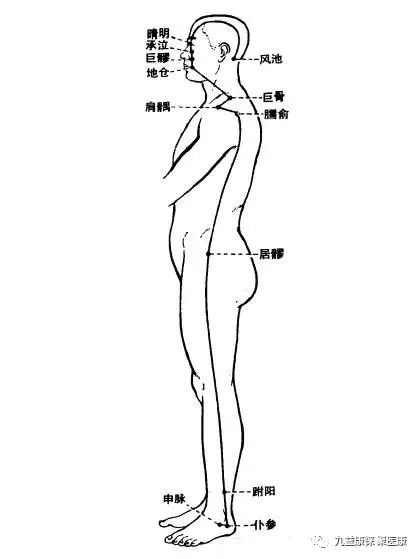
1) Pathway: The Yang Qiao Mai originates at the outer side of the heel from the Shen Mai point (申脉) of the Bladder meridian, ascends along the outer ankle, travels up the outer edge of the lower limb to the abdomen, ascends along the outer side of the chest, passes through the shoulder, neck, and reaches the corner of the mouth, arriving at the inner canthus of the eye. It then connects with the Yang Qiao and Taiyang meridians, ascending along the Bladder meridian to meet the Shaoyang meridian at the Fengchi point (风池穴) at the back of the neck.
2) Physiological Functions:
It controls the opening and closing of the eyes and muscle movement.
3) Key Acupoint: Shen Mai (申脉)
The Shen Mai point governs the Yang Qiao Mai and is a powerful Yang tonic for those with cold body conditions, effectively treating stiffness in the waist and back, and leg pain. The Yang Qiao connects with the Bladder meridian, and the Shen Mai point is an important point on the Bladder meridian. Thus, the Shen Mai point can dispel internal cold and promote Yang qi to reach the top of the head, balancing the body and enhancing agility.
The Shen Mai point is a crucial intersection of the Yang Qiao and Bladder meridians, and it is easy to locate, situated in the depression directly below the outer ankle bone. When the body is affected by cold, it tends to curl up and shiver, which in TCM is referred to as “contraction and retraction”. The Shen Mai point has the effect of stretching the meridians, quickly mobilizing the Yang qi of the body, allowing the cold to disperse as the Yang qi is sufficient, often treated with moxibustion.
7. Yin Wei Mai
The Yin Wei Mai originates at the intersection of the Yin meridians, connecting and regulating them.
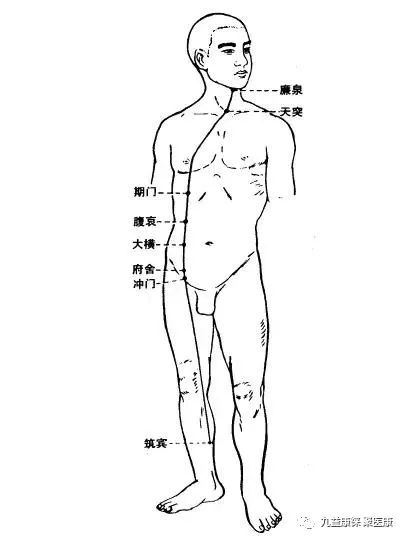
1) Pathway: The Yin Wei Mai starts at the Zhubin point (筑宾穴) located 5 cun above the inner ankle of the Kidney meridian, ascends along the inner side of the lower limb, reaches the abdomen, travels alongside the Spleen meridian to the ribs, intersects with the Liver meridian, and ascends to meet the Ren Mai at the Tian Tuo point, terminating at the Lian Quan point (廉泉穴) in the throat.
2) Physiological Functions:
The “Wei” in Yin Wei means to connect and regulate. The Yin Wei Mai serves to connect the Yin meridians.
3) Key Acupoint: Nei Guan (内关)
The Nei Guan point belongs to the Pericardium meridian, connects with the Ren Mai, and intersects with the Yin Wei Mai, governing the Yin Wei Mai. The true efficacy of the Nei Guan point lies in its ability to open the body’s internal mechanisms, benefiting qi and blood, calming the spirit, and enhancing beauty. Many women between the ages of 40 and 50 often experience symptoms such as palpitations, shortness of breath, and spontaneous sweating; the Nei Guan point can effectively address these issues.
According to ancient texts, women at this age are generally in a stage of decline, with aging beginning from the Yangming meridian, gradually leading to a decline in the qi and blood of the three Yang meridians. The head is the meeting point of all Yang meridians, and when the qi and blood cannot reach the face, wrinkles and spots appear. Beauty is closely related to qi and blood. The heart governs the spirit, and its radiance is reflected in the face. The spirit of the heart relies on qi and blood for nourishment; when qi and blood are abundant, it naturally reflects on the face, thus women should first nourish the heart for beauty.
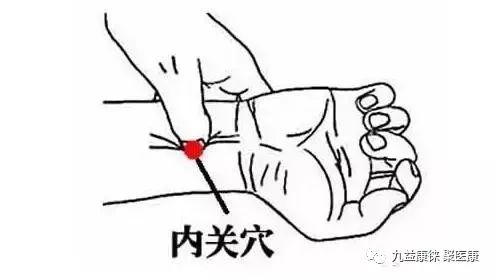
The Nei Guan point is also easy to locate, situated on the inner side of the arm, 2 cun above the wrist crease. To locate it, make a loose fist and place it palm up, aligning the index, middle, and ring fingers with the wrist crease; the point where the index finger touches is the Nei Guan point. This acupoint can be pressed or tapped at any time and place, with a slight feeling of soreness being ideal.
8. Yang Wei Mai
The Yang Wei Mai originates at the intersection of the Yang meridians, connecting and regulating them.
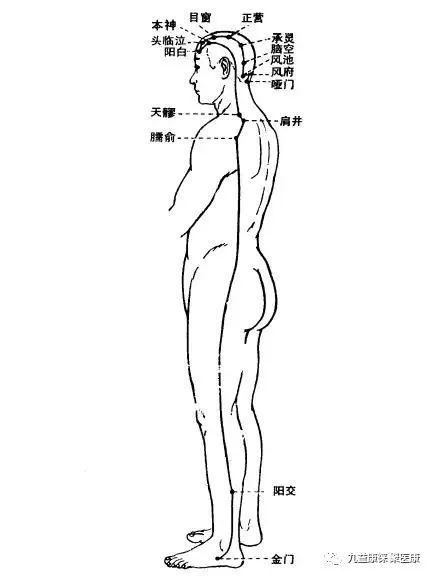
1) Pathway: The Yang Wei Mai starts at the Jinmen point (金门穴) of the Bladder meridian, passes over the outer ankle, ascends alongside the Shaoyang meridian, travels up the outer edge of the lower limb, ascends through the back and outer side of the trunk, from the back of the armpit to the shoulder, neck, and forward to the forehead, distributing along the sides of the head and back of the neck, meeting the Du Mai at the Fengfu point.
2) Physiological Functions:
It connects and regulates the Yang meridians.
3) Key Acupoint: Wai Guan (外关)
The Wai Guan point governs the Yang Wei Mai, connecting all Yang meridians, and has the functions of dispelling wind, relieving pain, and is effective for conditions of Yang deficiency, external chest pain, acute lumbar sprains, arthritis, and cervical spondylosis. The Wai Guan point is located 2 cun above the wrist crease on the dorsal side, opposite the Nei Guan point.
Additionally, the Wai Guan point is also known as the “Ear-Opening Point”. Traditional Daoist medicine believes that temporary hearing issues are manifestations of Yang deficiency. The Wai Guan point can invigorate the original Yang qi of the Sanjiao and facilitate the circulation of qi throughout the body. When this point is blocked, it can lead to a relaxed and collapsed eardrum that fails to return to normal.
Although the Eight Extraordinary Meridians do not belong to the organs and do not have paired relationships, they further strengthen the connections between the twelve meridians. For instance, the Du Mai oversees all Yang meridians, the Ren Mai governs all Yin meridians, the Da Mai restrains the vertical meridians, the two Qiao meridians govern the Yin and Yang sides of the body, and the two Wei meridians connect the Yin and Yang of the body. Furthermore, when the qi and blood of the twelve meridians and organs are abundant, the Eight Extraordinary Meridians can store and accumulate them. When the body’s functional activities require it, the Eight Extraordinary Meridians can also supply and nourish them. Therefore, addressing the eight key acupoints of the Eight Extraordinary Meridians can help adjust and treat related issues, greatly benefiting health.
Disclaimer: The content and images in this article are sourced from the internet, and all copyrights belong to the original authors and sources. If there are any copyright issues, please contact us promptly, and we will correct or delete the relevant content immediately.
Recommended Articles
1. Do this against a wall, and you will eliminate nine out of ten diseases, protecting yourself from all ailments! Countless people have benefited, and you could be next!
2. 46 Questions about Spinal Adjustment - Essence of Spinal Adjustment Theory and Practice!
3. One Finger Simi in Shijiazhuang/Zhengzhou/Shanghai (Decoding the Secrets of YD Tightening Techniques) for lactation, butt enhancement, postpartum recovery, and male enhancement training courses.
4. Last special price of 1800: Wang's Root Cutting Therapy and Organ Detoxification, Wool Carbuncle, Sublingual Thrombus Extraction, and Special Acupuncture Techniques

|
|
|

